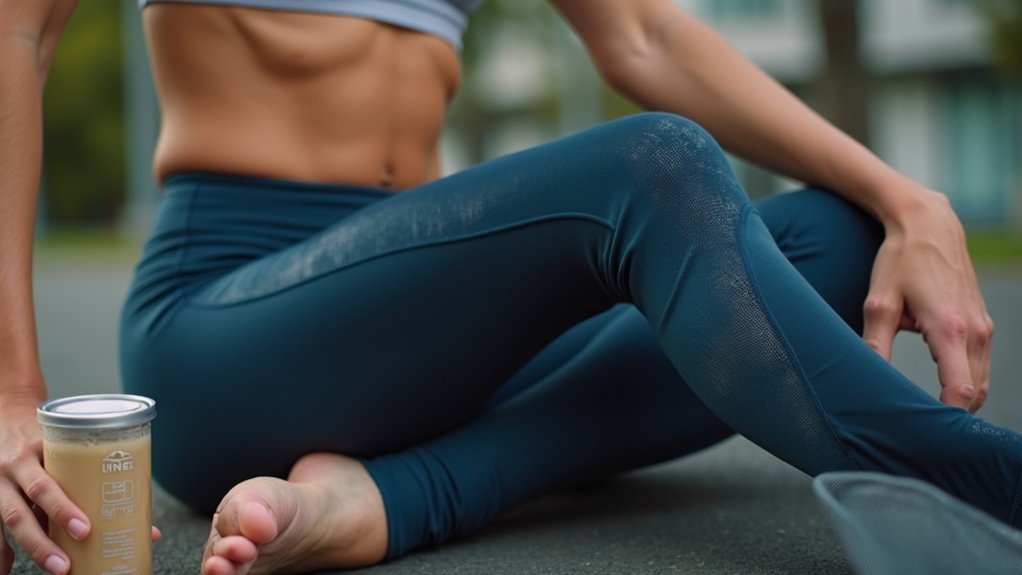Compression wear speeds recovery after jumping by applying graduated pressure that enhances blood flow, reducing muscle vibration and minimizing fiber damage. It accelerates the removal of metabolic waste products like lactate while decreasing inflammation markers in your muscles. You’ll experience less soreness, faster strength restoration, and improved sleep quality when wearing compression garments for 12-24 hours post-exercise. The right compression level (15-21 mmHg) offers significant advantages over other recovery methods without requiring active participation.
The Science Behind Muscle Recovery After Rebounding Workouts

While rebounding workouts offer exceptional cardiovascular benefits, they place unique physiological demands on your body. Each landing creates high eccentric loading, causing microscopic muscle fiber damage that requires repair.
Your muscles undergo significant stress during these workouts—phosphocreatine stores deplete rapidly as you produce explosive force, while the stretch-shortening cycle creates metabolic and mechanical strain. This combination triggers an inflammatory response critical to recovery. Plyometric movements utilize the stretch shortening cycle for rapid muscle contraction, contributing to the effectiveness of these high-intensity exercises.
The explosive demands of rebounding rapidly drain energy reserves, creating the necessary tissue stress for adaptation and growth.
During the 24-72 hours following your workout, satellite cells activate to repair damaged tissue while collagen synthesis accelerates. Your body simultaneously works to replenish glycogen stores, especially within the first two hours post-exercise.
Complete neuromuscular recovery typically takes 48-72 hours, meaning your rebounding performance will suffer without adequate rest between sessions.
How Compression Garments Reduce Trampoline-Induced Muscle Soreness
Compression garments work through graduated pressure systems that push blood from your extremities toward your heart, speeding recovery after intense rebounding sessions.
The tight fit greatly reduces muscle vibration during trampoline exercises, preventing microscopic muscle damage that leads to soreness.
You’ll benefit from faster clearance of metabolic waste products like lactate and creatine kinase, which directly contributes to decreased inflammation and quicker relief from post-workout discomfort. However, recent meta-analytical evidence contradicts these claimed benefits, showing no significant effect on muscle recovery regardless of exercise type.
Pressure Gradient Benefits
The pressure gradient mechanism in compression garments offers substantive benefits for trampoline enthusiasts seeking faster recovery and reduced muscle soreness. By applying graduated pressure—highest at the ankles (20-30+ mmHg) and gradually decreasing toward the thighs—these garments create an upward force that enhances blood flow against gravity. This gradient design effectively improves return flow of venous and lymphatic fluid from the exercised limbs.
| Pressure Effect | Physiological Benefit |
|---|---|
| Reduced vein diameter | Prevents valvular backflow |
| Enhanced interstitial pressure | Limits capillary leakage |
| Stabilized fascial compartments | Controls muscle oscillation |
| Accelerated lymphatic drainage | Expedites metabolic waste removal |
This controlled compression counteracts the blood pooling that typically occurs during jumping activities. You’ll experience faster circulation, improved oxygen delivery to recovering muscles, and minimized post-activity swelling—all contributing to quicker recovery times between trampoline sessions.
Reducing Muscle Vibration
Vibration control represents one of the most considerable benefits compression garments offer trampoline enthusiasts. When you land from a jump, your muscles oscillate, creating vibrations that can cause microtrauma and fatigue. Compression garments notably reduce these vibrations in both your quadriceps and hamstrings.
Research shows compression wear decreases peak acceleration in thigh muscles by up to 52% during vertical jumps. This stabilization occurs because the garments directly constrain surface tissue movement, limiting vibrations transmitted to deeper muscle layers.
You’ll experience reduced muscle activation in your rectus femoris and biceps femoris during landing phases, meaning your body works more efficiently to absorb impact. Studies have demonstrated that compression can significantly reduce soft tissue vibration magnitude by 15.1% during high-impact activities.
The result? Less exercise-induced muscle damage, reduced inflammation, decreased delayed-onset muscle soreness, and faster recovery between jumping sessions.
Enhanced Metabolite Clearance
During intense trampoline sessions, your muscles accumulate metabolic waste products that contribute to soreness and fatigue. Compression garments enhance your body’s ability to clear these metabolites through improved venous return and enhanced muscle pump function.
When you wear compression gear after jumping, you’ll experience faster lactate clearance from your bloodstream. This improved circulation helps flush out waste products that would otherwise prolong muscle soreness. The garments’ pressure gradient facilitates blood flow back to your heart, speeding nutrient delivery to recovering muscles.
While research shows mixed results, the benefits appear most significant in endurance activities and recovery protocols. You’ll likely notice greater advantages during longer trampoline sessions rather than brief jumps. The typical recommended pressure gradients range between 10-30 mmHg for effective recovery support, though optimal levels are still being researched.
Many athletes report reduced fatigue and quicker recovery when using compression wear as part of their post-exercise routine.
Optimal Timing: When to Wear Compression Gear After Jump Training
You’ll maximize recovery benefits by applying compression garments immediately after your jump training session, when initial inflammation reduction begins.
For ideal DOMS reduction, aim to wear compression gear for 12-24 hours continuously, which research shows greatly improves muscle repair processes.
While some athletes prefer overnight wear during sleep to extend the recovery window, you’ll capture the most critical recovery period by ensuring compression during the first 24-48 hours post-exercise. Multiple meta-analyses have demonstrated that compression garments provide moderate benefits for muscle strength and power recovery following intense exercise.
Immediate Post-Jump Application
Timing plays an essential role in maximizing the benefits of compression wear after intense jump training.
You’ll get best results by applying compression garments within 30-60 minutes after your jump session, when the initial inflammatory response begins.
Aim for compression between 15-21 mmHg at the ankle and calf to enhance blood flow without restricting movement.
Wear your compression gear for 2-4 hours initially, though extending up to 12 hours intermittently provides cumulative benefits.
This timing effectively reduces muscle oscillation and limits exercise-induced swelling in your lower limbs.
The immediate application doesn’t impair your performance in subsequent training sessions.
Instead, it preserves strength and power output while accelerating lactate clearance—particularly important if you’re engaged in high-intensity jumping protocols.
Research confirms that compression garments significantly reduce muscle damage markers such as creatine kinase and lactate dehydrogenase following intense activity.
Overnight Recovery Benefits
The significant benefits of compression wear extend well beyond the initial post-jump period into overnight recovery, a timeframe when your body conducts much of its repair work.
Wearing compression tights for 8-12 hours overnight accelerates the removal of fatigue markers like lactate and creatine kinase while enhancing lymphatic drainage.
You’ll preserve muscle strength more effectively—studies show a 155N difference compared to control groups—and experience less next-day strength deficits.
Research confirms that compression sportswear provides enhanced motor performance during recovery periods, leading to better functional outcomes the following day.
You’ll notice reduced perceived soreness and improved sleep quality as compression minimizes nocturnal muscle stiffness.
The mechanical stability provided prevents microtrauma by limiting muscle oscillation during sleep.
For peak results, apply full-leg graduated compression tights (20-30 mmHg) within an hour post-jumping exercise.
This protocol maximizes recovery benefits when your body needs it most.
Extended Wear Considerations
Determining the ideal timeline for compression wear after jump training can considerably impact your recovery outcomes and training adaptations.
While the general recommendation is 12-24 hours post-exercise, your individual needs may vary based on training intensity and recovery response.
- Wear compression immediately after jumping sessions when muscle damage and inflammation are highest.
- Consider keeping garments on for at least 6-8 hours to maximize circulatory benefits.
- For overnight recovery, looser compression may improve comfort and guarantee you maintain wear during sleep.
- Adapt duration based on soreness levels—extend wear time if experiencing significant DOMS.
Remember that compression works best alongside proper hydration and nutrition.
The discomfort of extended wear should be balanced against recovery benefits, making personal tolerance an important factor in your compression strategy.
Research shows the most significant recovery benefits occur within the first 24 hours post-exercise, when compression garments are most effective at reducing muscle soreness and improving circulation.
Performance Benefits: Bouncing Back Faster With Compression Technology
While traditional recovery methods often leave athletes waiting days for relief, compression technology accelerates the journey back to peak performance.
You’ll experience considerably reduced muscle soreness within the first 24 hours post-exercise, especially after eccentric movements like jumping or downhill running.
Your functional recovery improves measurably—cyclists and runners regain pre-exercise performance levels 6% faster with compression during recovery.
This technology helps maintain quality movement patterns between training sessions and may enhance proprioception during multidirectional movements.
The benefits extend to fatigue reduction, with consistently lower subjective fatigue ratings compared to non-compression recovery. Research shows this is particularly evident in the New Zealand study where runners wearing compression reported reduced soreness after completing a 10k run.
For best results, wear compression garments within the first 48 hours post-exercise when the greatest benefits occur, enabling higher training frequency with reduced recovery time.
Choosing the Right Compression Wear for Rebounding Exercise Recovery

Now that you understand compression’s recovery benefits, selecting appropriate garments becomes your next priority.
When recovering from intense rebounding sessions, you’ll want compression wear that targets the most stressed muscle groups while providing ideal comfort and support.
- Compression Level: Choose moderate to high compression (20-30 mmHg) for immediate post-workout recovery, and lighter compression for overnight use.
- Activity-Specific Design: Compression tights or socks work best for trampoline exercises as they support calf and thigh muscles that absorb landing impact.
- Material Quality: Look for breathable, moisture-wicking fabrics that prevent overheating during extended wear. Selecting high-quality materials ensures enhanced blood circulation while reducing muscle soreness.
- Proper Fit: Verify garments are snug but not restrictive—they should promote circulation without causing discomfort.
Comparing Compression to Other Post-Trampoline Recovery Methods
Compression garments represent just one tool in the recovery arsenal for rebounding enthusiasts. While they provide passive recovery through consistent pressure, other methods offer distinct benefits. Understanding these differences helps you create an ideal post-jumping recovery strategy. Compression apparel is particularly effective for trampoline users as it significantly minimizes vibrations that cause microtrauma during repetitive jumping.
| Recovery Method | Primary Mechanism | Convenience Factor |
|---|---|---|
| Compression Wear | Hydrostatic pressure | High (wear during/after) |
| Hydrotherapy | Similar pressure effects | Low (requires facility) |
| Active Recovery | Enhanced blood flow | Medium (requires movement) |
The data shows compression garments work similarly to hydrotherapy by applying pressure that reduces swelling and promotes circulation. Unlike active recovery or massage, you’ll benefit from compression’s passive nature – simply wearing them during and after your trampoline session provides recovery benefits while you continue with your day.
Research-Backed Benefits for Vertical Training Recovery

When examining evidence-based recovery methods, scientific research consistently validates compression garments’ efficacy for vertical training recovery. These specialized clothes create graduated pressure that enhances blood flow and supports muscle repair after intense jumping sessions. The effects are particularly pronounced in trained individuals, with research showing they experience greater strength and power recovery benefits than untrained populations.
Compression garments deliver scientifically proven recovery benefits through graduated pressure that optimizes blood flow and accelerates muscle repair.
- Reduced DOMS: Lower perceived muscle soreness and decreased damage biomarkers allow quicker return to training
- Faster strength recovery: Mitigates post-exercise strength decline, maintaining vital peak force output
- Sustained power production: Higher mean power during repeated jumps compared to loose-fitting attire
- Decreased muscle damage: Limits creatine kinase release while reducing intramuscular swelling
You’ll also experience psychological benefits as compression enhances proprioception and joint stability, potentially improving your landing mechanics and boosting confidence for subsequent high-impact sessions.
Frequently Asked Questions
Can Compression Garments Help With Injury Prevention During Jumping Activities?
Yes, they can help prevent injuries during jumping by reducing frontal-plane knee motion, improving joint stability, and enhancing proprioception. You’ll benefit from decreased valgus angles that may lower your ACL injury risk.
Do Compression Garments Work Equally Well for All Body Types?
No, compression garments don’t work equally well for all body types. You’ll see better results if you’re leaner with more muscle mass, as proper skin-to-garment contact guarantees ideal pressure distribution and effectiveness.
Are There Any Negative Side Effects to Wearing Compression Gear?
You won’t experience major negative effects from compression gear if sized properly. Potential issues include temporary discomfort, skin irritation from trapped moisture, and theoretical circulation concerns that rarely materialize in practice.
How Long Do Compression Garments Typically Last Before Needing Replacement?
Your compression garments typically last 1-2 years or 150-200 uses. Athletic wear degrades faster with high activity, while medical compression socks need replacement every 3-6 months. Watch for loosening elastic and fabric thinning.
Can Compression Wear Benefits Be Measured for Recreational Versus Professional Athletes?
Yes, compression wear benefits are measurable in both groups, but you’ll see different metrics: professionals track power preservation with specialized equipment while you’ll notice DOMS reduction and subjective recovery improvements as a recreational athlete.
In Summary
You’ll recover faster from rebounding workouts when you wear compression gear after jumping. The graduated pressure increases blood flow, reduces muscle oscillation, and decreases inflammation. Don’t wait too long—put on your compression wear immediately after trampoline sessions for maximum benefits. Research confirms you’ll experience less soreness and bounce back quicker when you make compression technology part of your vertical training recovery routine.





Leave a Reply